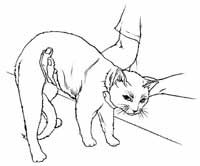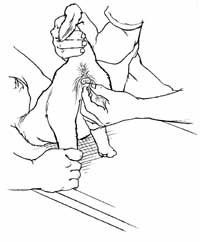An area of concern to cat owners and veterinarians is lower urinary tract disease, medically known as Feline Lower Urinary Tract Disease (FLUTD). This disease is not limited to male cats but is of great danger to them because of their anatomy. The male cat has an extremely small tube (urethra) leading from the bladder through the penis.
In most cases the inflammation of the bladder causes the formation of a crystalline substance in the urine, which will clog the urethra of male cats and make urination impossible. This will be evidenced by the cat straining in the litter pan as if constipated and producing only small drops of urine, crying while straining, squatting outside the litter pan, and licking its genital area frequently.
Advertisement
If the cat is plugged and cannot urinate, the kidneys will lose the ability to remove the waste products from the blood. This causes a buildup of nitrogen byproducts in the blood known as uremia, which can lead to death. A blocked male cat that is vomiting is probably uremic and will die if not treated immediately. Call your veterinarian, regardless of the time of day or night.
Female cats also get FLUTD, and though the symptoms are the same as those of a male, females will not plug up, and the midnight emergency does not exist.
Some of the signs to watch for are a cat urinating outside the litter box; straining to urinate evidenced by going in and out of litter box and squatting for long periods of time; blood in urine; excessive licking of genital area; vomiting with these signs. If a cat is showing signs of urinary tract disease, use the following cat care tips:
If the Cat is Male
Advertisement

